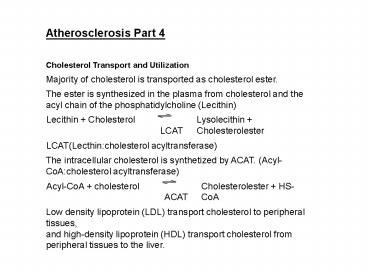Atherosclerosis Part 4 - PowerPoint PPT Presentation
1 / 11
Title:
Atherosclerosis Part 4
Description:
and high-density lipoprotein (HDL) transport cholesterol ... After the synthesis in the endoplasmic reticulum, the LDL receptor matures in the Golgi complex ... – PowerPoint PPT presentation
Number of Views:27
Avg rating:3.0/5.0
Title: Atherosclerosis Part 4
1
Atherosclerosis Part 4
Cholesterol Transport and Utilization
Majority of cholesterol is transported as cholesterol ester.
The ester is synthesized in the plasma from cholesterol and the acyl chain of the phosphatidylcholine (Lecithin)
The intracellular cholesterol is synthetized by ACAT. (Acyl-CoAcholesterol acyltransferase)
Low density lipoprotein (LDL) transport cholesterol to peripheral tissues,and high-density lipoprotein (HDL) transport cholesterol from peripheral tissues to the liver.
Lecithin Cholesterol LCAT Lysolecithin Cholesterolester
LCAT(Lecthincholesterol acyltransferase) LCAT(Lecthincholesterol acyltransferase) LCAT(Lecthincholesterol acyltransferase)
Acyl-CoA cholesterol ACAT Cholesterolester HS-CoA
2
Control of Cholesterol Biosynthesis
1) HMG-CoA reductase The enzyme synthesis inhibited Hydroxy cholesterols Phosphorylation dephosphorylation (active)
2) Hormonal regulation insulin cortisol, glucagon
3) Dietary cholesterol intake "feedback inhibitory"
4) LDL (Low-density Lipoprotein) receptor regulation
5) n-3 polyunsaturated fatty acids
6) Drug action on HMG-CoA reductase (statins)
3
The LDL receptor pathway
4
The LDL receptor pathway (cont.)
Plasma LDL is taken up by cells via LDL receptors in clathrin-coaated pits. LDL are separated from their receptor in endosomes (pH 5 to 6) then undergo digestion in lysosomes (pH 3). The LDL receptors recycle back to the cell surface making lt100 trips in their lifetime. Lysosomal enzymes breakdown apoB100 in LDL to amino acids and liberate cholesterol for cellular needs. The cellular level of cholesterol is self-regulating. An oversupply of cholesterol has three metabolism effects inhibition of HMG-CoA reductase - The rate limiting step in cholesterol synthesis. activation of ACAT, which esterifies cholesterol for storage inhibition of LDL receptor synthesis
5
Hereditary Hyperlipoproteinamias
Dysbetalipoproteinemia Accumulation of IDL, VLDL and chylomicron remnant. Elevated level of total cholesterol and triglycerides. The disorder caused by Apo-E or Apo-E receptor. Diabetes, hypothyroidism are associated with type III disorders. Abetalipoproteinemia Genetic defect in the synthesis of Apo-B. Both chylomicron and VLDL are affected. Fat malabsorbtion occurs because chylomicron can not be formed by intestine. Multiple type hyperlipoproteinemia Increased level of VLDL and LDL which is resulted from the overproduction of VLDL. The biochemical defect is unknown. Familial hypecholesterolemias LDL receptor downregulation or receptor defects. Homozygotes do not have functioning LDL receptor. The gene defect is caused by mutation, deletions, insertions.
6
Cholesterol Homeostasis in FH
FH Familial HypercholesterolemiaLDL receptor failed to migrate from endoplasmic reticulum to Golgi Homozygous form (rare)cholesterol level above 650 mg/ 100 mlThey die before age 20. Heterozygous form (one defective allele)cholesterol level 250 - 500 mg/ 100 mlhigh risk to have heart attack
7
Involvement of the LDL receptor in cholesterol uptake and metabolism
Regulatory actions of cholesterol
After the synthesis in the endoplasmic reticulum, the LDL receptor matures in the Golgi complex then migrates to the cell cell surface, where it clusters in coated pits. After internalization of LDL, multiple vesicles fuse to form endosome. Proton pumping in the endosome membrane causes the pH to drop, which in turn cause LDL to dissociate from the receptor. The LDL apolipoprotein is degraded in lysosomes. The LDL receptor remains in a vesicle, which returns to the plasma membrane to start the cycle anew.
8
Structure of the LDL receptor
The structure is divided into five domains. The first domain contains the LDL binding site. This is followed by a large domain that contains homology with the epidermal growth factor (EGF) precursor. Next, is a small segment that contains a large number of O-linked carbohydrate residues. The fourth domain spans the plasma membrane. The last domain is a short segment that projects into the cytoplasm but does not have any kinase activity.
9
Hyperlipoproteinemia phenotypes
Phenotype Lipoprotein elevation Major plasma lipid elevation
I Chylomicrons Triglycerides
IIa LDL Cholesterol
IIb LDL and VLDL Cholesterol and triglycerides
III b-VLDL and IDL Cholesterol and triglycerides
IV VLDL Triglycerides
V VLDL and chylomicrons Triglycerides and cholesterol
10
Diseases of Lipoprotein Metabolism Caused by Single Gene Defects
Disease Lipoprotein abnormality Lipid abnormality Metabolic basis Clinical implications
Familial hyper-cholesterolemia LDL elevated Cholesterol elevated Decrease clearance of LDL from plasma. Familial form results from genetic deficiency or abnormality in LDL receptor. Risk factor for atherosclerosis
Familial hyper-triglyceridemia VLDL elevated Triglyceride elevated Uncertain VLDL overproduction or decreased catabolism. Questionable as to whether this is an independent risk factor for atherosclerosis
Familial combined hyperlipidemia LDL and VLDL elevated Cholesterol and triglyceride elevated Uncertain overproduction of apo-B-100 Risk factor for atherosclerosis
Familial dysbeta-lipoproteinemia b-VLDL and IDI elevated Cholesterol and triglyceride elevated Decreased clearance of remnants defective binding of apo E to LDL receptor Risk factor for atherosclerosis
Familial lipoprotein lipase deficiency Chylomicrons and VLDL elevated Triglycerides elevated Deficiency of lipoprotein lipase or apo-C-II Acute pancreatitis
Hypoalpha-lipoproteinemia HDL reduced None Uncertain occasionally caused by genetic apo-A-I/apo-C-II deficiency Risk factor for atherosclerosis
11
Dietary Therapy of High Blood Cholesterol Level
Nutrient Recommended Intake
Nutrient Step-One Diet Step-Two Diet
Total fat Less than 30 of total calories Less than 30 of total calories
Saturated fatty acids Less than 10 of total calories Less than 7 of total calories
Polyunsaturated fatty acids Up to 10 of total calories Up to 10 of total calories
Monounsaturated fatty acids 10 to 15 of total calories 10 to 15 of total calories
Carbohydrates 50 to 60 of total calories 50 to 60 of total calories
Protein 10 to 20 of total calories 10 to 20 of total calories
Cholesterol Less than 300 mg/d Less than 200 mg/d
Total calories To achieve and maintain desirable weight To achieve and maintain desirable weight































